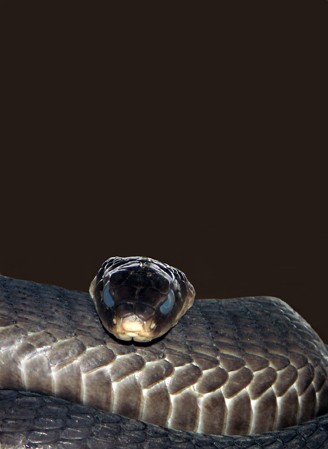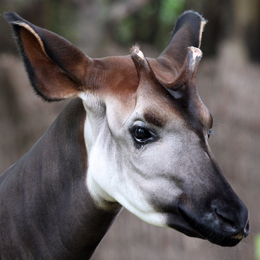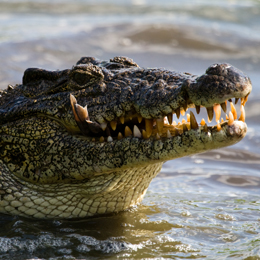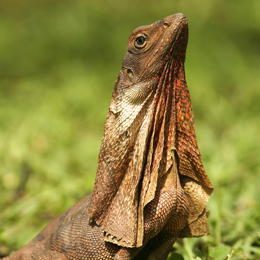Physical Description
An adult Black mamba grows to an average size of 2 – 2.7 m (6 – 9 ft) in length. There are reports documenting a Black mamba specimen growing as long as 4.3 meters (14.1 ft). A Black mamba weighs 1.6 kg (3.5 lb) on an average. The lifespan of the species remains undetermined till today. However, it has been observed that they can live up to 11 years in captivity.
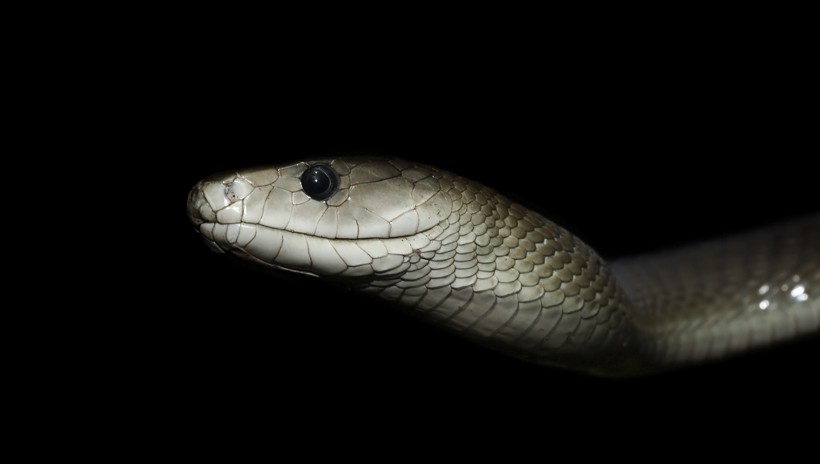
The Black mamba is a deadly species that is identified by the inky-black interiors of its mouth.
?
Image credits: Kaneos Media/Shutterstock
The Black mamba is a deadly species that is identified by the inky-black interiors of its mouth. The slender snake is quite aggressive, unlike the Green mamba. Its scientific name Dendroaspis polylepis is a direct reference to the species having a high scale count as compared to many others of the same genus. The original name is from the ancient greek where Dendro means tree and aspis snake. Poly can be translated to many or multiple and lepis means scales, referring to the high scale count of this particular snake of the tree dwelling mamba genus.
Anatomy
Black mambas are not black in color but have been named because of the presence of the inky-black interiors of their mouth. They actually occur in various shades or colors of which the most commonly observed is dark gray and white.
They have been spotted also with a brownish or khaki colored surface as well. As compared to an adult Black mamba, juveniles are light colored showcasing an olive brown or pale gray skin tone. For this reason, they are often confused with the Green mamba.
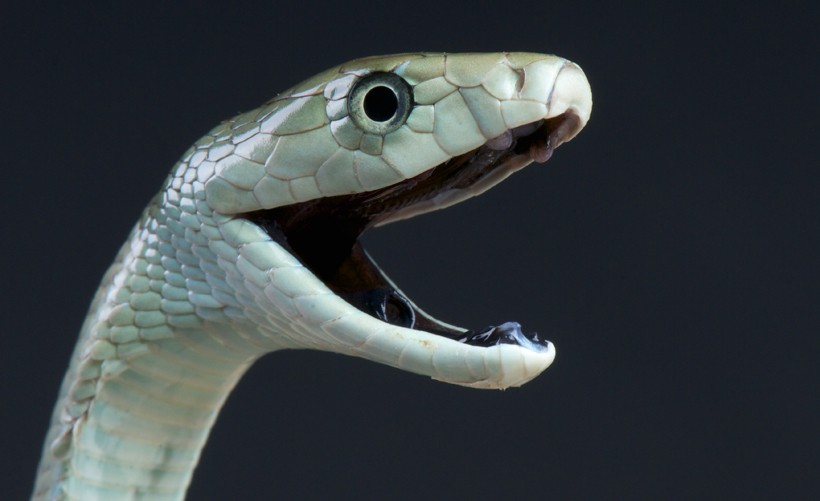
Black mambas are commonly observed with a dark gray or white colloring
?
Image credits: reptiles4all/Shutterstock
The Black mamba is an agile, elegantly built and round bodied snake with a progressively tapering tail. This cold-blooded snake relies on external heat and, therefore, can often be found basking during the day on a low ranch or on large rocks. A Black mamba consists of a triangular, blunt shaped head with a pronounced brow ridge and medium sized eyes. The underbody or belly of the Black mamba is either pale yellow, cream colored or a mix of both shades. The body of this species might also showcase dark mottling around the posterior ends forming oblique bars. It is also called a proteroglyphous snake since it has fangs as long as 6.5 mm CHECK OF CM located right at the front of the maxilla.
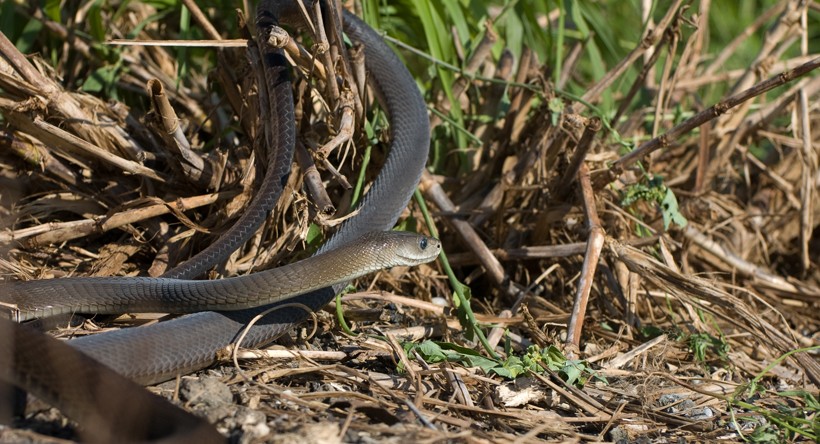
An adult Black mamba grows to an average size of 2 – 2.7 m (6 – 9 ft) in length
?
Image credits: Heiko Kiera/Shutterstock
The Black mamba showcases a unique scale count with smooth scales that are prominent in the mid body. It displays an average of 23 – 25 dorsal scale rows, 248 – 281 ventral scales and 109 – 132 paired subcaudal scales. The anal plate is divided and there is a vast number of scale rows present at the preoculars (3 – 4) and postoculars (2 – 5). While the lower labials showcase 11 – 13 scale rows, the upper labials have on an average 7 – 8 scale rows.
Habitat
The Black mamba is a species that prefers a tropical habitat which is generally engulfed with rocks and trees. It is also known to inhabit the Savannah grasslands of the sub-Saharan regions in Africa. Such regions provide a good hiding place for the snake for attacking its prey and escaping several predators both terrestrial and aerial. Besides dense forests, they also prefer rocky hills, riparian forests and woodlands.
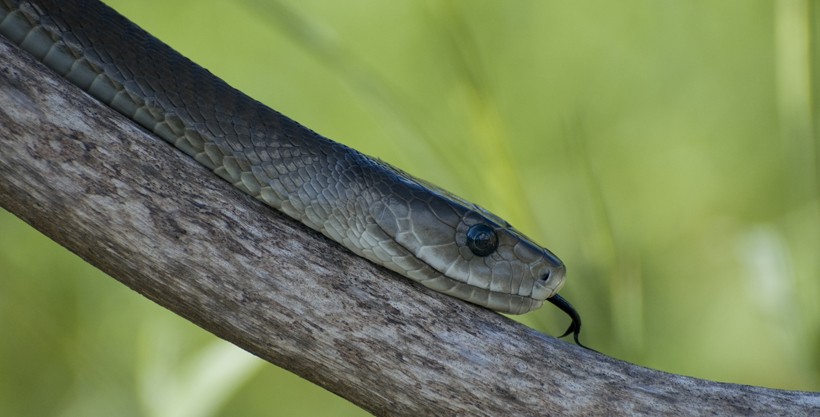
Perfect camouflaged black mamba on a branch
?
Image credits: Heiko Kiera/Shutterstock
One can find a Black mamba hiding in hollow trees and termite mounds since the species is arboreal. Black mambas can easily adapt to a number of habitats right from swamps to dense woodlands and can easily thrive on very little food in a humid climate. A Black mamba often digs permanent lairs to pass its leisure time. Besides forests and grasslands, they can also reside near water bodies, usually lakes and ponds rather than river streams.
Geographical Distribution
The Black mamba, found primarily in the sub-Saharan African continent, is a native Ethiopian species that doesn’t showcase any migration pattern. They can also be found in the northern forests of Africa as far as Eritrea. Their distribution extends till the southern portion of the continent across South Africa as far as western Namibia. However, in the western region Black mambas are observed on rare occasions. The species occupies the dense tropical forests and open grasslands of Kenya, Uganda, Zimbabwe, Angola, Nigeria and Mali. Appearances in the Dakar region of Senegal in the West African region have also been witnessed of the Black mamba.
Diet
Black mambas are voracious feeders and are highly aggressive predators. They often feed on small rodents, amphibians and reptiles. Birds perched on tree tops are a favorite delicacy for Black mambas especially since they are arboreal in nature. Though unconfirmed, a Black mamba can also devour eggs laid by birds and other terrestrial reptiles. Bush babies, rock hyrax and bats also form a part of its daily diet.
Prey
The Black mamba is a fast-moving snake and is known for being an ambush predator. It prefers constructing lairs in terrestrial habitats where it dwells as well as trees since it is also an arboreal species. Hunting takes place from a specific lair, whereafter the snake returns to its regular residence after feeding. When hunting, the Black mamba raises a part of its body off the ground, a method which is quite similar to jumping on a prey. It doesn’t latch onto its prey but injects a certain dose of venom through a bite whereafter it wait till the prey is paralyzed and died before consumption.
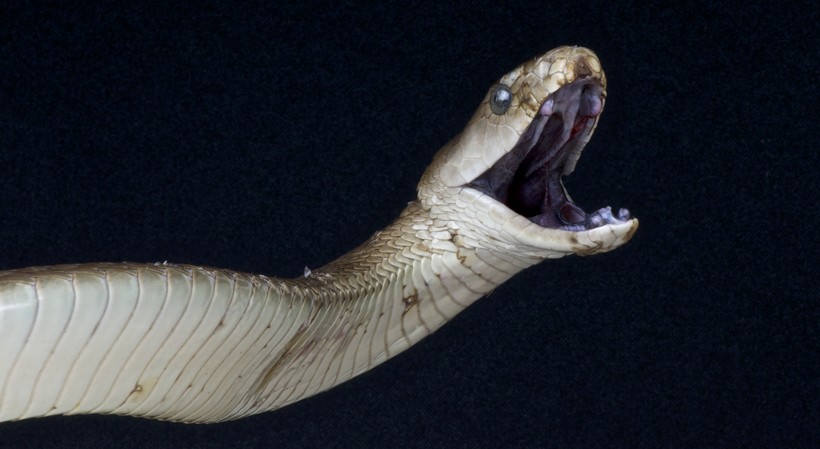
The Black mamba has inky-black fangs
?
Image credits: reptiles4all/Shutterstock
If the prey attempts to escape or defend, the Black mamba is capable of delivering rapid strikes continuously to incapacitate its prey. It preys on small mammals on terrestrial grounds and birds like parrots when it is perched atop a tree. Mammals, small rodents like rats and squirrels, constitute a major part of the snakes' diet. Besides small rodents, the Black mamba also preys on bush babies and the rock hyrax. It is a tremendously agile species that is diurnal and, therefore, hunts during the day. At night, it returns to its burrows or rock crevices located on rocky hills, sugarcane plantations and scrublands.
Predator
Adult Black mambas face an aerial threat from birds of prey like eagles, hawks and kites like the Black-chest snake eagle and the Brown snake eagle. The Cape file snake eagle is another species that is particularly immune to the African snake venom, preying commonly on many mamba species. The Black mamba is often also preyed upon by mongooses, monitor lizards and recently humans have also become a major threat to the species. The Mongoose often hunts juvenile Black mambas and destroys nests feeding particularly on the eggs.
Reproductive Cycle
The Black mamba tends to breed annually with its mating cycle initiating in the spring season. Like all reptiles, Black mambas are dioecious which means they reproduce sexually. The breeding season is a period during which male Black mambas tend to be highly aggressive and can be easily agitated. Sexual dimorphism is almost negligible with both male and female adult having the same appearance.
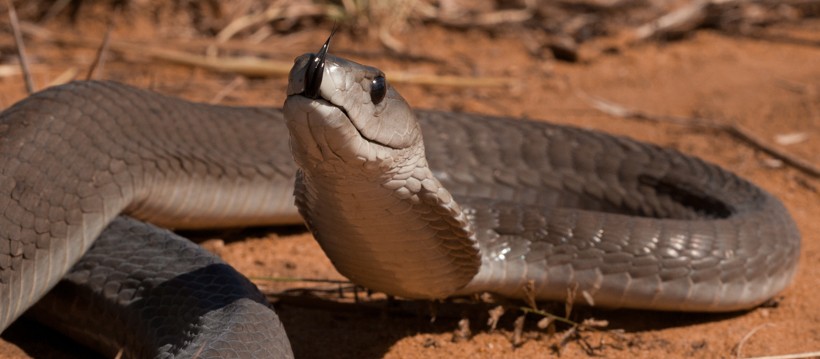
Black mambas sexually reproduce by producing amniotic eggs.
?
Image credits: Andre Coetzer/Shutterstock
Black mambas breed in the month of September showcasing a distinct mating ritual where the males fight for the right to mate with a particular female. This takes place in the form of a ‘wrestling match’ or dual to capture the female’s attention. It is a form of showcasing strength and dominance once a female mate has been found. Male mambas locate their prospective mates by following the scent of the female. Upon finding a suitable partner the male inspects the female by flicking its tongue all over the body of its mate.
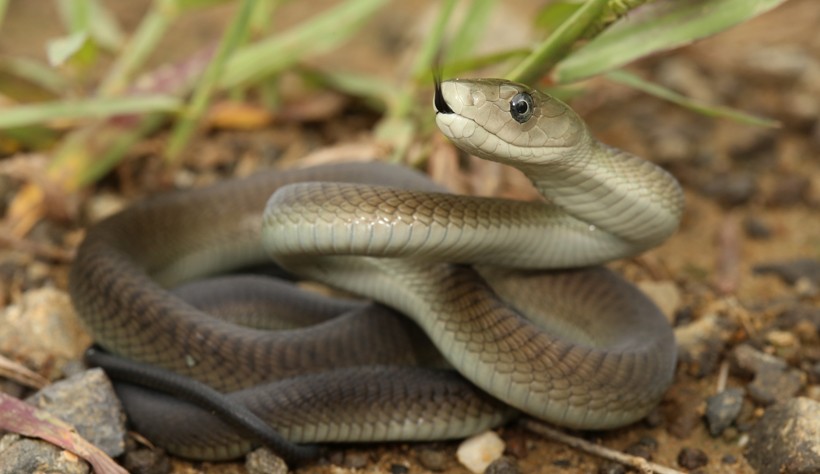
Female black mambas produces a batch of 6 – 17 eggs.
?
Image credits: NickEvansKZN/Shutterstock
Female Black mambas are oviparous and maintain a gestation period which lasts around 60 days after which the female produces a batch of 6 – 17 eggs. Once exposed to the external environment the female incubates the eggs for a time span of 60 days. Before incubation, the female Black mamba tends to build an ideal nest composed of mounds of dirt, fallen twigs and leaves. During such a phase female mambas tend to be very aggressive and territorial showcasing a protective nature. Post incubation, juvenile Black mambas break through the egg shell with an egg tooth. They are found to be born with fully developed venom glands making them lethal predators within minutes of their birth. The egg yolk is also absorbed into the body of the newborn Black mamba as a source of nourishment since they are abandoned by their mother right after birth.
Behavior
The Black mamba is a unique reptile that is considered to be one of the fastest reptiles in Africa. Despite the fact that it is known to be a lethal predator, the species is, in fact, a timid snake that attacks at the slightest threat. It is an agile and fast-moving snake that can stay well hidden in bushes or atop of trees and easily camouflage itself in its natural habitat. The skittish and often unpredictable behavior displayed by a Black mamba makes it a near perfect predator.
Black mambas tend to avoid confrontation. However, during certain periods they can act quite territorial. This is usually witnessed during the mating season.
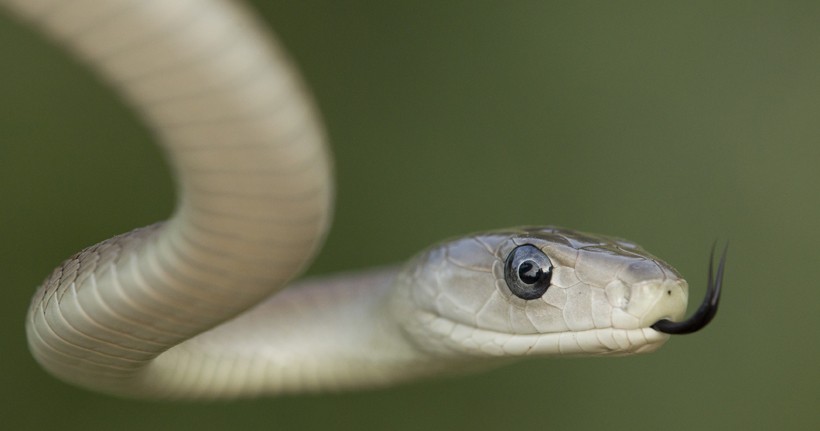
The black mamba uses the tongue to smell environment, South Africa
?
Image credits: Stuart G Porter/Shutterstock
Black mambas are also believed to have a shy and secretive nature and thus, try to avoid unnecessary dangers and threats. The species rarely crosses path with humans. However, due to habitat loss, they have begun finding shelter in sugarcane plantations. It is only upon confrontation that the Black mamba tends to show an aggressive side all the while hissing and finding ways of landing a strike. This hissing is quite audible and is a behavioral adaptation for defense. Sudden movements often aggravate a Black mamba resulting in a series of rapid strikes and bites as many as 45 times. Owing to its slender body and size, a Black mamba is capable of raising its body well off the ground. It can easily lunge towards its prey which is a method it uses while hunting birds or rodents.
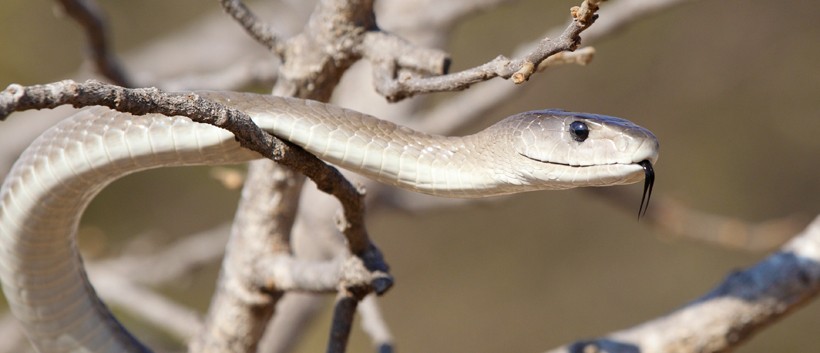
The black mamba is an arboreal snake
?
Image credits: Dennis W. Donohue/Shutterstock
Unlike other reptiles, Black mambas favor solitude and individuality over herds, especially as they are territorial. Black mambas are diurnal creatures, meaning they usually are active a few hours post-sunrise until an hour before dusk. They spend a large amount of their time basking on rocks usually returning to a favorable spot after a feed. Communication observed in a Black mamba is rare since it depends upon sight for catching sudden movements. Although their ears are absent they still can detect vibrations from the ground because of the presence of the Jacobson’s organ. While hunting they attack their prey twice or thrice and then wait till the prey is paralyzed. Once dead, it swallows and digested the prey as a whole within 8 – 10 hours aided by certain acids produced within its body.
Threats & Conservation
Black mamba is a venomous snake in Africa that is also suffering a decrease in its native population. The main cause for this decrease is habitat loss due to human-induced activities and interference. The number of attacks of the species on humans has increased because it has started to dwell in burrows located within agricultural plantations. Nevertheless, it is safe to assume that the population currently is stable. However, they could suffer a massive blow especially since the momentum with which human encroachment is progressing can soon result in serious conflicts. According to the IUCN, the current status on the Red List of the Black mamba is ‘Least Concern’.
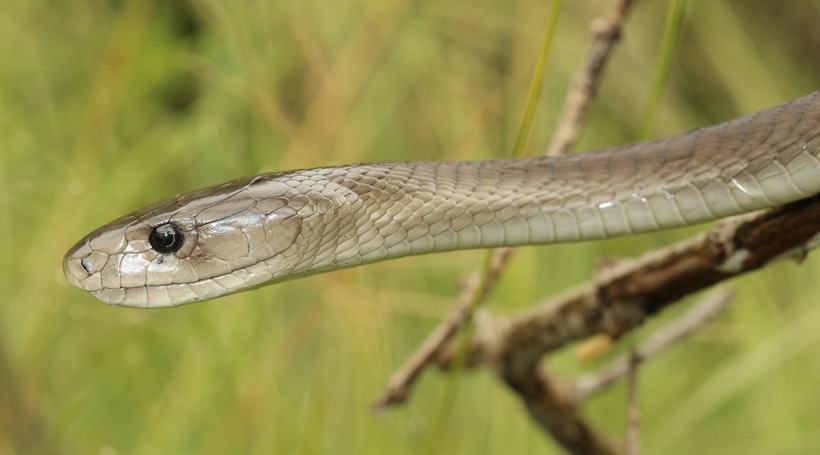
According to the IUCN, the current status of the Black mamba is ‘Least Concern’.
?
Image credits: NickEvansKZN/Shutterstock
Black mambas are terrestrial creatures and often tend to protect their reserved territories against unwanted threats or nuisance. Being shy in nature they often get nervous and retreat when a human approaches. However, if the species feels threatened it can strike back multiple times leading to devastating incidents. Research suggests that they play an important role in controlling the rodent population. Due to habitat fragmentation and illegal poaching, the species can suffer from other problems like inbreeding. The typical ecosystem of a Black mamba occurs in an extensive, interior plateau that is undulating, rugged and forested. The South Africa bushveld is a habitat of dense savannah grasslands that is diverse with rich flora and fauna, in particularly a luxuriant birdlife. However with the decrease of its habitat, not only the species is losing its nesting burrows and lairs, but also its prey. With continuous felling of trees, the Black mamba can no longer dwell as an arboreal species, and native birds are driven away from their nesting grounds causing austerity of diet. So far no conservation policies or schemes have been introduced to preserve the Black mamba species and their habitat.
Funfacts
- The Black mamba is one of the most feared venomous snakes in the world.
- A Black mamba possesses a deadly combination of speed, unpredictable behavior and potent venom.
- The Black mamba is the fastest snake in Africa. It is believed that they are able to outrun a horse over a short distance of 40 ft.
- Two male Black mambas fighting against each other are often mistaken for being mates.
- Black mambas sexually reproduce by producing amniotic eggs.
- Black mambas prefer to avoid contact with humans and are frightened by their mere presence.
- The Black mamba is known as the most venomous snake of the African region even surpassing the King Cobra. Its venom is extremely lethal and can result in death within 20 minutes if an antidote is not administered.
- The Black mamba grows to an average length of 4 – 6 ft; There are even records of a specimen that was 14 ft in length.
